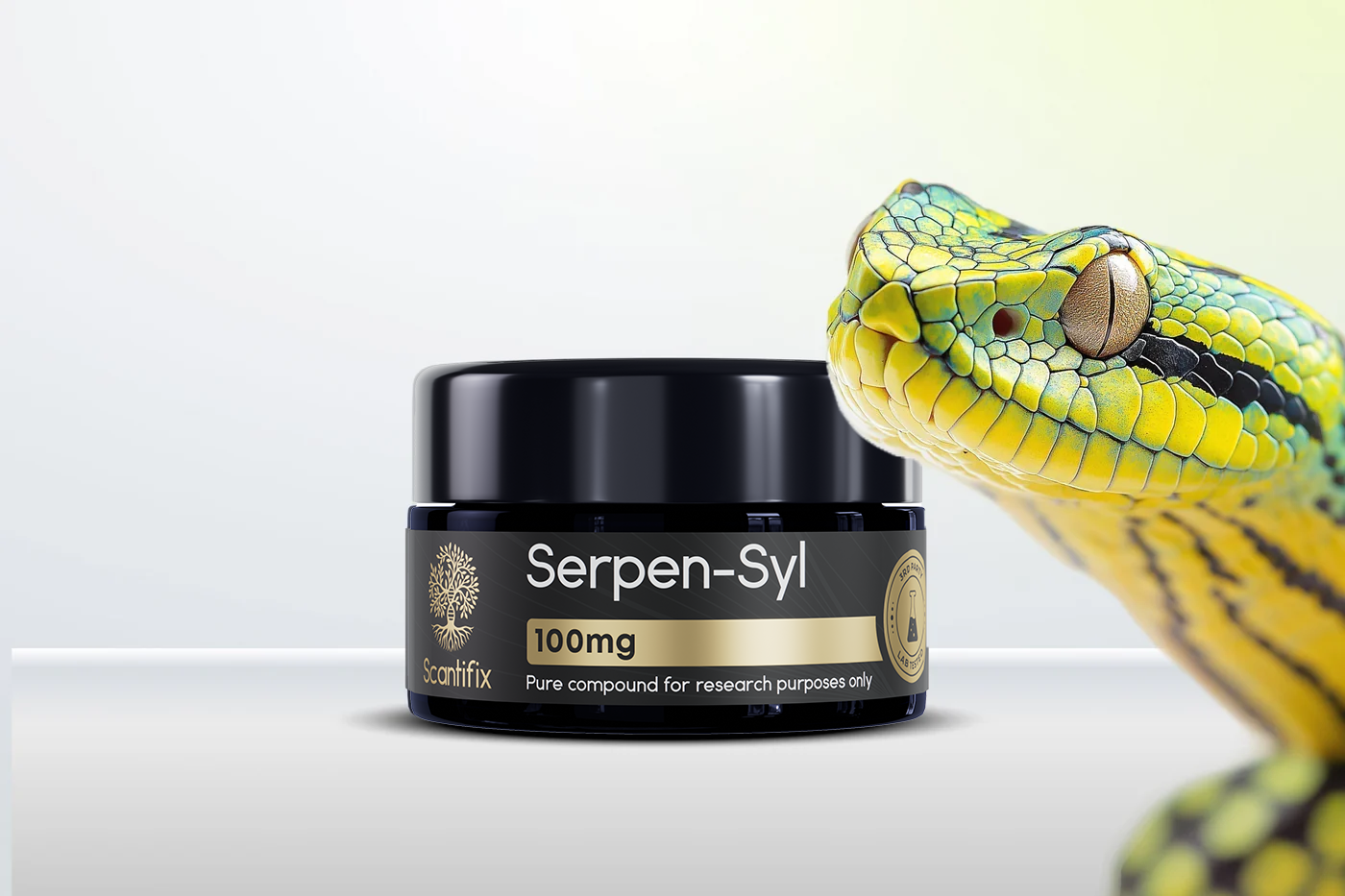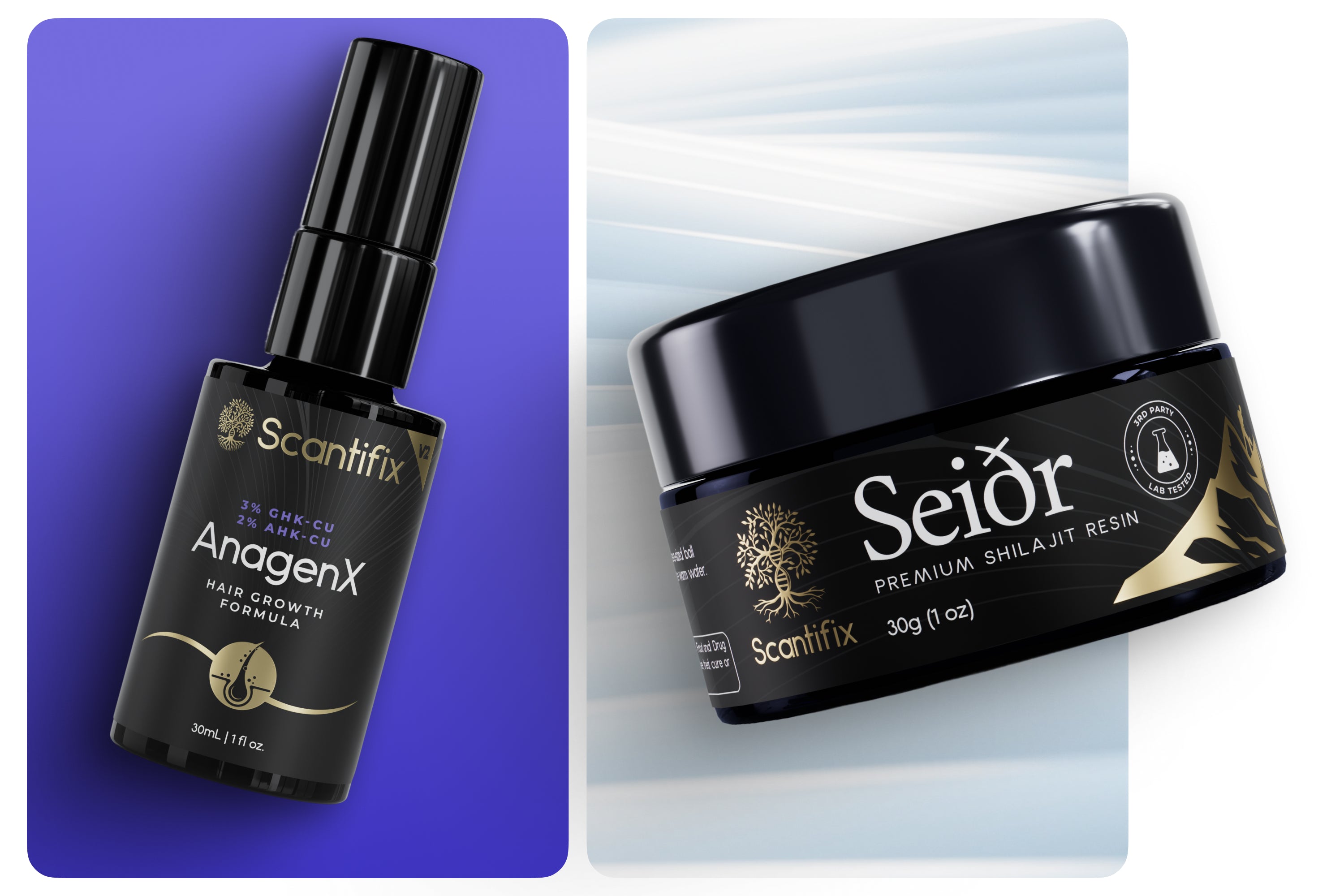Ever wondered who’s really behind the solutions you shop at Scantifix?
Meet TK Jensen—the CEO, founder, formulator, developer, and the driving force behind every product. With deep roots in the biohacking and peptide space, TK has been ahead of the curve since the early days, founding the Exploring Peptides community long before peptides became the skincare buzzword they are today.
In this interview, we dive into the story of Scantifix, explore the world of peptides, take a peek at what’s coming next, and even get a look into TK’s personal skincare routine. Ready? Let’s get into it
What inspired you to start Scantifix?
In my early 20s, I collapsed while backpacking in Thailand and ended up hospitalized for three weeks. During that time, I almost died. Twice. It was kidney failure caused by severe infections, a viral infection, parasites, and mercury poisoning.
This started my journey into natural health and “Biohacking.” I later discovered peptides, and at that time there was very little info, this was back in 2012, so I started my own community on FB and began educating myself, and later others.
I have also been struggling with acne for most of my life, and I have very sensitive skin. Everything I could buy or get my hands on had so much junk inside, preservatives and fillers, that I simply could not use them. So I started experimenting and making my own formulas. I guess that’s where Scantifix really originated: In my bedroom/office back in 2012. But back then, I had no idea that, 11 years later, it would actually turn into a company.
What has been the most surprising lesson you’ve learned on your journey as a founder?
The most surprising lesson I have learned is the lack of innovation and transparency in the cosmetic space. More specifically, I believe that 95% of the industry relies on “off-the-shelf” base formulas, meaning they don’t actually create much of anything—they just add some ingredients to a base formula, slap some labels on it, and start marketing.
That’s what surprised me the most. That, and the fact that most manufacturers require you to purchase 5,000 units even on your first run. So for many new businesses in the space, if you don’t really have any good knowledge on how to formulate or any ideas, you just end up with some cookie-cutter formula that never really delivers any form of innovation to the industry.
And for the people that actually dabble in true innovation, they are hiding behind proprietary formulas that don’t really tell you much of anything. Don’t get me wrong, I don’t have anything against proprietary formulas in the pure sense, when the product is great. It’s more that we don’t really know the ingredients in there or the amounts, and to me, that’s a problem.
Also, lastly, the saying “cosmetic grade” - this is a very loose term used in the industry to describe an acceptable low-purity product used in a cosmetic formula. And here, I have seen anything from 80% purity up to 95% purity described as cosmetic grade. The problem with that is that you are essentially using an active ingredient that has potential impurities in it, and it’s accepted because you “only” put it on your skin and don’t consume it. But as we know today, what goes on your skin also ends up in your body in most cases, so that whole logic never resonated with me.
That is why I decided I would take part in changing that while also solving my own problem, and that is actually having access to high-quality, third-party tested cosmetic ingredients that don’t have harsh chemicals.
From your perspective, what sets Scantifix apart from other brands in the beauty and wellness industry?
We question every ingredient. Does it need to be in there to begin with? What does it actually do or contribute? At Scantifix, we want labels that don’t take you half an hour to read. We want the ingredients to make sense, and not ingredients that you need to run through Google Translate.
And we’re not just talking the talk. We actually 3rd-party test our ingredients at an independent lab in the U.S., especially the actives, to make sure that they have the highest purity we can possibly get.
Are there any breakthrough technologies or ingredients in your formulations that you’re particularly excited about?
YES! So starting out, I was a bit worried that I had to add some sort of regular preservative system such as alcohol. Not that alcohol is always bad, but there are many weird variations used. I was able to find a company that specializes in natural, stabilized, functional preservative systems with probiotics and natural antimicrobial peptides that can provide the same effects while also giving BENEFITS. I know it sounds crazy, I was blown away too, haha. Who knew?
How did you first discover the power of peptides, and what drew you to them?
After my near-death experience in Thailand, I was completely bedridden and unable to function for years. I developed so many issues, and that led me down a deep rabbit hole in my research, where I eventually found the BPC-157 peptide and tried it for my persistent gut issues and leaky gut with amazing results.
What do you think is the biggest misconception people have about them?
This is a tough one, I really have to think about this one. Well, I think the biggest misconception is their use cases, or the lack of proper understanding of how wide an area they cover. Peptides can truly be miraculous, and I have personally witnessed thousands of positive testimonials from people getting rid of conditions that had previously ruined their lives.
How do Scantifix’s peptide formulations differ from others on the market?
We differ in several ways, the most important being that we are the first cosmetic manufacturer to 3rd-party test our peptides for purity. We also use the highest purity grade on the market, including the world’s first 100% pure GHK-Cu. As I mentioned before, in the cosmetic space, there is a lot of “cosmetic grade” thrown around, and that has such a broad definition. It can mean they use 85% purity peptides. It can mean they use other active ingredients that are not something you’d want on your skin due to high residues of synthesizing chemicals left in with the peptides.
Just so you understand, the purity of our ingredients exceeds not only cosmetic-grade standards but also pharmaceutical standards.
What were the biggest challenges you faced in building Scantifix, and how did you overcome them?
Finding good people to work with that shared my values. And honestly, even when I found good people, I had to sort of force their hands into thinking differently, haha.
The cosmetic industry, as I see it, has not really innovated what I call the base formulas for a long time, or the only innovation is adding more junk to them instead of removing it. So, finding people to work with, finding manufacturers that share my values and are also able to work with a lower minimum order quantity, was important, because the last thing I want to do is have inventory sit and collect dust for 12 months. People don’t realize this, but peptides are “fresh goods” in the sense that as soon as you put them into a solution, the time starts ticking. They don’t break down to zero, but they start deteriorating, and I obviously want all my products to have max potency at all times.
Are there any exciting new solutions on the horizon?
Haha, I’m always dabbling in new solutions, and YES, there are some quite exciting things in the pipeline! I’m currently working on an everyday anti-aging hyaluronic acid peptide formula that will be game-changing, to say the least. A clean, everyday formula focused on aging skin, wrinkles, firmness, and just overall glow. And here’s another thing I see often in this industry: 0.0000001% actual peptide content, and in my opinion, that’s borderline scamming people.
So imagine getting a highly effective product with high peptide concentration and no nonsense laundry list of additives. Well, we’re about to find out this year how that will go.
Also, I’m actively working with another team of scientists to make liposomal peptides in a way I can get behind. We’re doing a lot of testing there. And there are some other cosmetic products, like eyelash and eyebrow growth serum, and a couple of other things I want to keep secret for now...
How does Scantifix approach sustainability, as a growing concern in the beauty industry?
In my opinion, there is zero reason for us to ever consider animal testing. It breaks my heart in half when I see companies claiming to be cruelty-free yet still test on animals. That is not sustainable or ethical, in my opinion.
Also, plastic packaging. I have a serious issue with microplastics. It ends up in everything these days, and I’m actively seeking to get rid of it. Glass is the way to go. It’s reusable, recyclable, and you don’t have to worry about microplastics. There are some areas, such as the caps on the bottles, where it’s just not possible yet to use any other material, but as soon as there is a solution for that, we’re cutting that too.
Peptides themselves are synthesized from amino acids that, again, are synthesized, so it’s a very sustainable way of creating cosmetics using them as active ingredients.
What has been the most rewarding part of your journey so far?
Honestly, every time you create a new product and the first batch finally arrives, it’s such a great feeling knowing that I created that from scratch and that it’s an honest and innovative product. There’s no better feeling in the world.
Do you have a favorite Scantifix solution?
Probably the one I teased before. The all-in-one Hyaluronic Acid Peptide serum that’s coming soon, and I’m very, very excited for when it’s ready!
Okay, time to get real. What does your skincare routine look like?
Hahaha, this is funny, because you know what the hardest thing about results is? Consistency. And yes, I absolutely can slack off here as well, and I have given myself a promise that this year I will seriously step up my game to fully practice what I preach.
So right now, I use the Dome Beamer for 30 minutes in my office, for the hair and also the brain benefits of red light therapy. Then I try to use the Reviva Lux mask for 30 minutes too, while I work.
In the morning, I start by cleaning my face with a hypochlorous acid spray. I’ve been struggling with acne since I was 16 years old, and this was something I found six months ago to be really effective as an AM/PM rinse.
So I wash my face, then I apply the new HA serum, I have, of course, created some bottles for myself to try it out, haha.
Then I brush my teeth, apply the Dental Matrix for a couple of minutes, rinse, spit, and that’s it until the evening when I do the same thing again.
Once a week, I microneedle, and twice a week I use a 2% salicylic acid solution on my face to reduce pore size and sebum production. I also use that on my scalp. I’m not going bald yet, but I do have it in my family, so I’m trying to stay proactive and keep my natural hair for a LONG time.
With technology advancing rapidly, what new trends in health and care do you think readers should pay attention to?
Red light therapy is a big one. I really think people should pay attention and read the studies. I think in five years, a lot of people will have red light therapy devices. Also, circadian re-training - go out and watch the sun in the mornings. It’s free! And it sets your entire biochemistry up for success.
Another thing is microneedling, specifically microneedling with serums. Previously, you could only do this at spas and salons, but now it’s widely accessible. And I have just purchased a centrifuge and equipment to make my own PRF at home to use with my Hydro Derma Pen QS, so I’m very excited to start incorporating that into my routine. PRF is like a newer version of PRP, which was, and still is, almost only available at clinics.
Imagine you had a magic wand to transform your industry. What would you change?
I would change the acceptable amount of additives and require every formula and base formula to be reviewed, and all excessive or unneeded additives to be thrown out. I would also require an AI model to be developed that could simulate animal testing, so animal testing itself would stop happening altogether.
How do you see the beauty and wellness industry evolving in the next few years?
Honestly, I don’t see it changing much, except, of course, Scantifix and our innovations. And I hope I can inspire others to take our path and just push through the work. I’m not scared of competition. I welcome it with open arms. It excites me! But I do feel like natural and functional preservative systems will become more frequently used, as I see a demand from consumers, and I hope this will start trending in a positive direction.
Last question: If you could give one piece of advice to someone looking to get into cosmetic peptide research, what would it be?
Start with a good, simple serum, just to see what you think of it and make up your own mind. Something like GHK-Cu + Snap-8 is a great way to start. Mixing these raw peptides, like we carry, with a simple, clean serum such as Cosmedica Pure Hyaluronic Acid Serum is, I think, a great way to get into it!

|
 |
 |
 |





Leave a comment
All comments are moderated before being published.
This site is protected by hCaptcha and the hCaptcha Privacy Policy and Terms of Service apply.